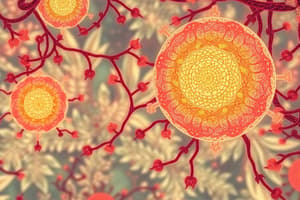Podcast
Questions and Answers
Which of the following transport mechanisms requires the cell to expend energy?
Which of the following transport mechanisms requires the cell to expend energy?
- Osmosis
- Diffusion
- Active Transport (correct)
- Facilitated Diffusion
A cell is placed in a solution with a lower solute concentration than inside the cell. Which of the following best describes the tonicity of the solution relative to the cell?
A cell is placed in a solution with a lower solute concentration than inside the cell. Which of the following best describes the tonicity of the solution relative to the cell?
- Hypotonic (correct)
- Isotonic
- Hypertonic
- Equilibrium
Which of the following is the primary characteristic of a semipermeable membrane that directly contributes to its selective nature?
Which of the following is the primary characteristic of a semipermeable membrane that directly contributes to its selective nature?
- Its ability to generate energy
- Its hydrophobic nature
- Its variable pore size (correct)
- Its uniform pore size
In the context of cellular homeostasis, which process directly involves the movement of water across a semipermeable membrane?
In the context of cellular homeostasis, which process directly involves the movement of water across a semipermeable membrane?
What condition is achieved when the concentration of solutes is equal on both sides of a cell membrane?
What condition is achieved when the concentration of solutes is equal on both sides of a cell membrane?
A cell needs to import a large molecule against its concentration gradient. Which transport mechanism is most suitable for this task?
A cell needs to import a large molecule against its concentration gradient. Which transport mechanism is most suitable for this task?
If a cell is placed in a hypertonic solution, what is the net direction of water movement?
If a cell is placed in a hypertonic solution, what is the net direction of water movement?
Which of these scenarios requires cells to expend energy to maintain homeostasis?
Which of these scenarios requires cells to expend energy to maintain homeostasis?
Flashcards
Homeostasis
Homeostasis
Maintaining a stable internal environment despite external changes.
Cell Homeostasis Requirements
Cell Homeostasis Requirements
Cells must exchange materials, remove waste, obtain energy and replicate.
Semipermeable Membrane
Semipermeable Membrane
Cell membranes only allow certain molecules to pass through.
Passive Transport
Passive Transport
Signup and view all the flashcards
Active Transport
Active Transport
Signup and view all the flashcards
Diffusion
Diffusion
Signup and view all the flashcards
Osmosis
Osmosis
Signup and view all the flashcards
Concentration Gradient
Concentration Gradient
Signup and view all the flashcards
Study Notes
- Homeostasis maintains a constant internal state in a changing environment
Cell Requirements for Homeostasis
- Cells must exchange materials
- Cells must eliminate waste
- Cells must obtain and use energy
- Cells must make new cells
Exchange of Materials for the Cell
- Cell membranes are semipermeable, meaning that only certain particles can move in or out of the cell (selective)
Passive Transport
- Materials are transported straight through the cell membrane.
- This process does not require energy.
Active Transport
- Materials are transported through protein channels in the cell membrane.
- This process requires energy.
Concentration Gradient
- Molecules move randomly from high concentration to low concentration.
Diffusion
- Diffusion is a type of passive transport
- Diffusion involves the movement of molecules from an area of high concentration to an area of low concentration.
- Particles diffuse from areas of more concentration to less concentration
Osmosis
- Osmosis is a type of passive transport
- Osmosis involves the movement of water through a semipermeable membrane from areas of higher concentration to areas of lower concentration.
- Water moves from areas of less concentrate to more concentrate
Definitions
- Concentration gradient refers to the uneven distribution of a substance across a border
- Solute refers to particles dissolved in water
- Solution is a mixture of water and a solute
Isotonic
- Equilibrium; same concentration in 2 different areas
Hypertonic
- The area with a higher concentration of solute (less water)
Hypotonic
- The area with a lower concentration of solute (more water)
Water
- Water is essential for cells
- Water moves across the cell membrane by osmosis
- Water movement depends on the concentration of water inside and outside the cell
Studying That Suits You
Use AI to generate personalized quizzes and flashcards to suit your learning preferences.




